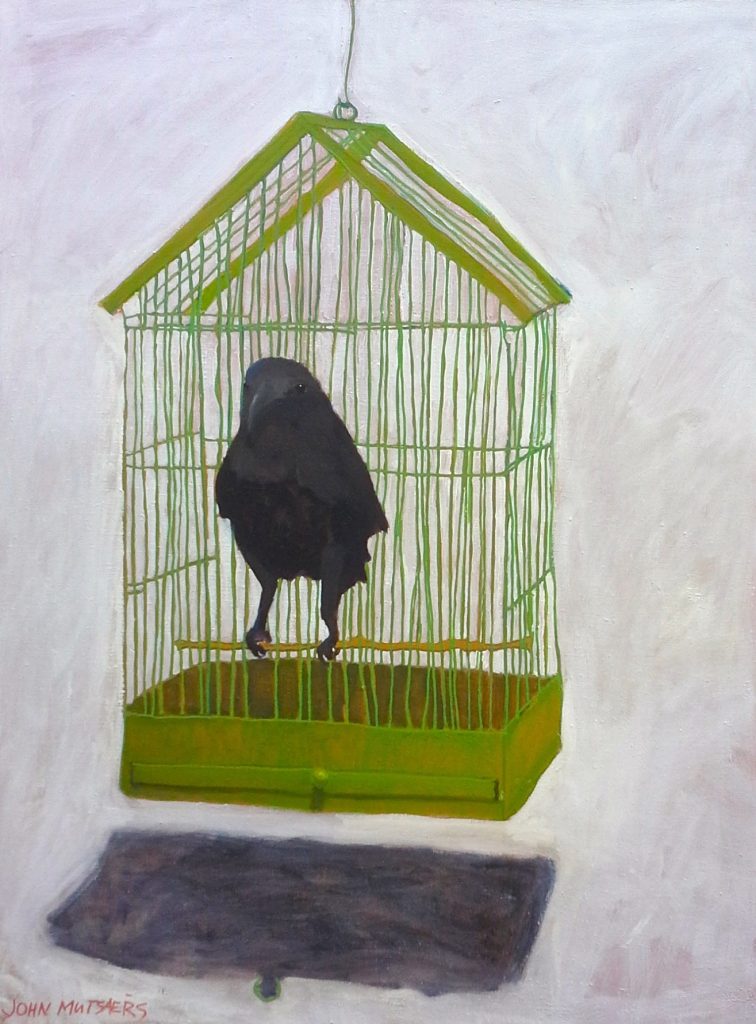John Mutsaers Painter - Inverlock, Australia
Can you discuss your series, ‘The Infinite Birdcage’?
As this series is somewhat organic it makes it hard to suggest the number of works I will complete. It seems that as I work on one canvas, themes and concepts for the next canvas continually percolate and gather their own energy. At this stage, however, I am thinking 12 – 14 canvases of various sizes. So far I have completed six paintings. The other consideration is that I am collaborating with composer/musician Mark Finsterer, who is writing a piece of music for each painting therefore there has to be limit to the final number of paintings. Also selected authors will comment on the works each drawing from their own experience and understanding of freedom. It is our intention to publish a book with CD.
“A good head and good heart are always a formidable combination, But when you add to that a literate tongue or pen, then you have something very special.” Nelson Mandela
Finding Freedom in a Cage, Oil on Canvas, 61 x 91cms
The combination of people and birds
So far people feature in only three of the works. However, that will change from painting to painting as I it is obviously about the human understanding of freedom. I want to make a powerful impression regarding our responsibility to take good care of the gift of freedom. I can’t know how birds feel about freedom; I can only work through my own perception of how I would feel if I were locked up for the rest of my life. I am somewhat fascinated with the idea that when caged birds whistle or sing our perception is that it is a sign of their happiness and contentment. I think that this is what we want to believe because it reinforces our own need for freedom.
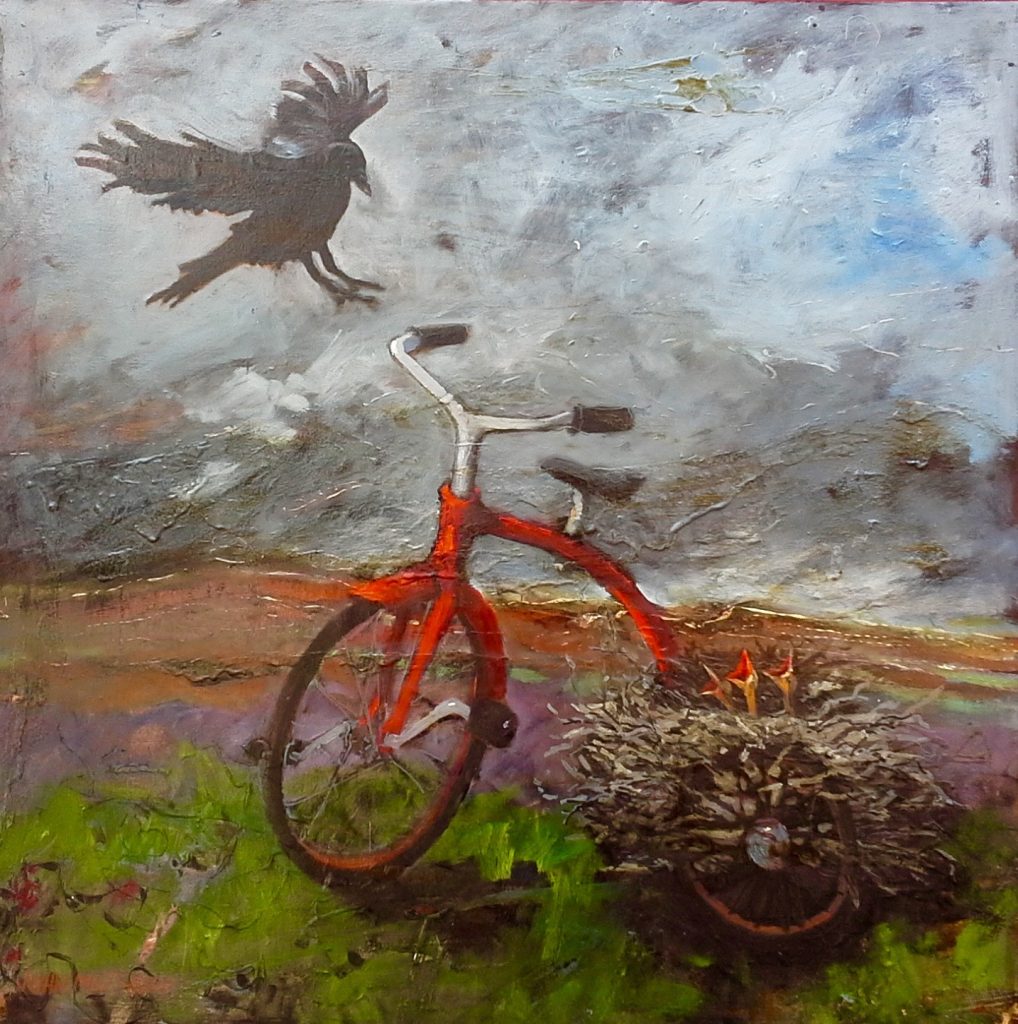
One Minute after midnight, Oil on Canvas Board, 98 x 98 cm
The combination of birds and machinery
At this stage I have only included a tricycle, which I see more as a child’s toy rather than a machine. The inclusion of toys is becoming a strong attraction for me because of their inherent innocence; perhaps an attempt to see things through children’s eyes.
The combination of birds and animals
For more than forty years my studio was next to a farm. From my window I often saw the ease in which cows and birds live in harmony.

Free as a Bird in a Bovine State, Acrylic and Oil on Canvas, 92 x 92 cm
Humour
I am told I have a good sense of humour and sometimes it gets in the way of a serious conversation. However, in this body of works the underlying theme is critical and any observed humour would be in perception of the viewer.
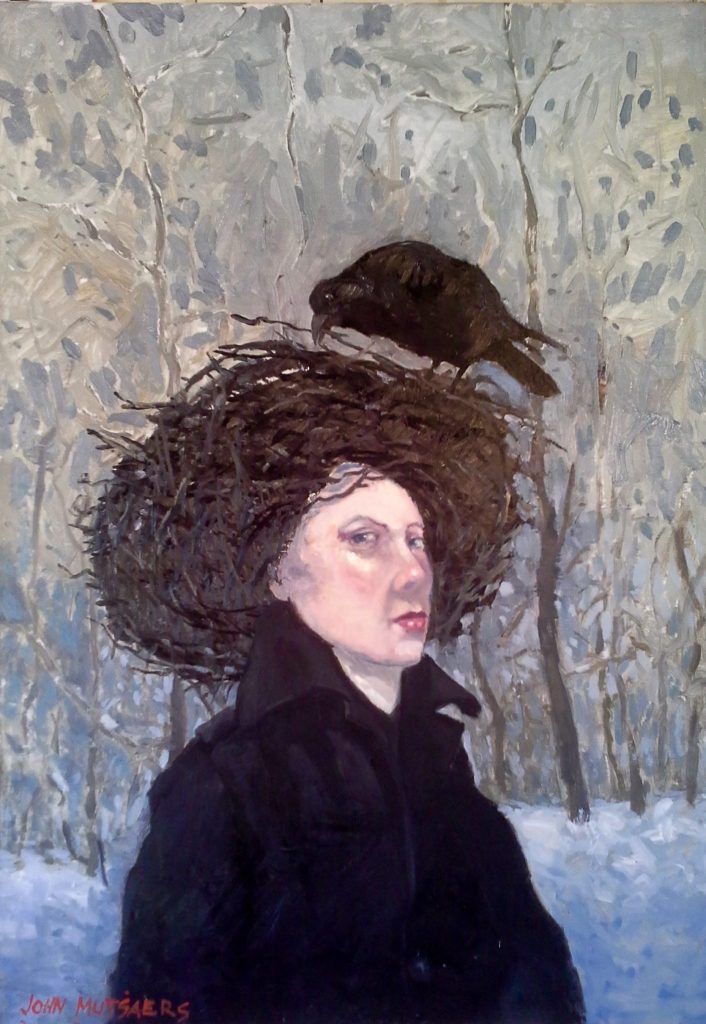
Girl with a Birdnest Hairdo, Oil on Linen, 70 x 100 cm
How do you know when to end working on a series?
The age old question of when is a painting truly finished could also apply to a series. The temptation to reconstruct, or, to continue working past and beyond the point where everything that needs to be said, has been said, is the artist’s dilemma. There is something in me that always want to do the next and the next after that but eventually I discipline myself to say it is finished.
How do you use a series as impetus in your work?
A series is a frame-by-frame intellectual exploration of my journey through a theme. I really like working this way because of the instalment nature of the process. As I have explained before some ideas that come to mind when working on one canvas are often inappropriate for that particular painting and become a concept for the next in the series.
Discuss the extension of this series through, music, poetry and essays?
Although I was born in Europe during WW11 my experience of freedom comes from early memories, but mostly from the stories told by my parents and what I read and see in news items on television. I came to Australia in 1956 as a thirteen year old and since then my experience has been one of a white European male living in a country where freedom is easily taken for granted. The musician and the authors are from diverse backgrounds and most have spent time in other cultures consequently their understanding of freedom will be different from mine.

Discuss how you use your environment in your art and landscapes.
I don’t think that artists anywhere can seriously paint a subject, including landscapes, without some intellectual vigour. One way or another the environment is on everybody’s mind. In this age every artist who paints the landscape must be aware of how things change continually. The whole idea is to bring a concept to the viewer that has impact and provokes enjoyment and emotion. To simply go out and copy a pretty landscape without giving some interpretation or impression should be a thing of the past. No matter what the style, painting is a language and artists are translators.
My environment informs my translation and therefore is integral to my work.
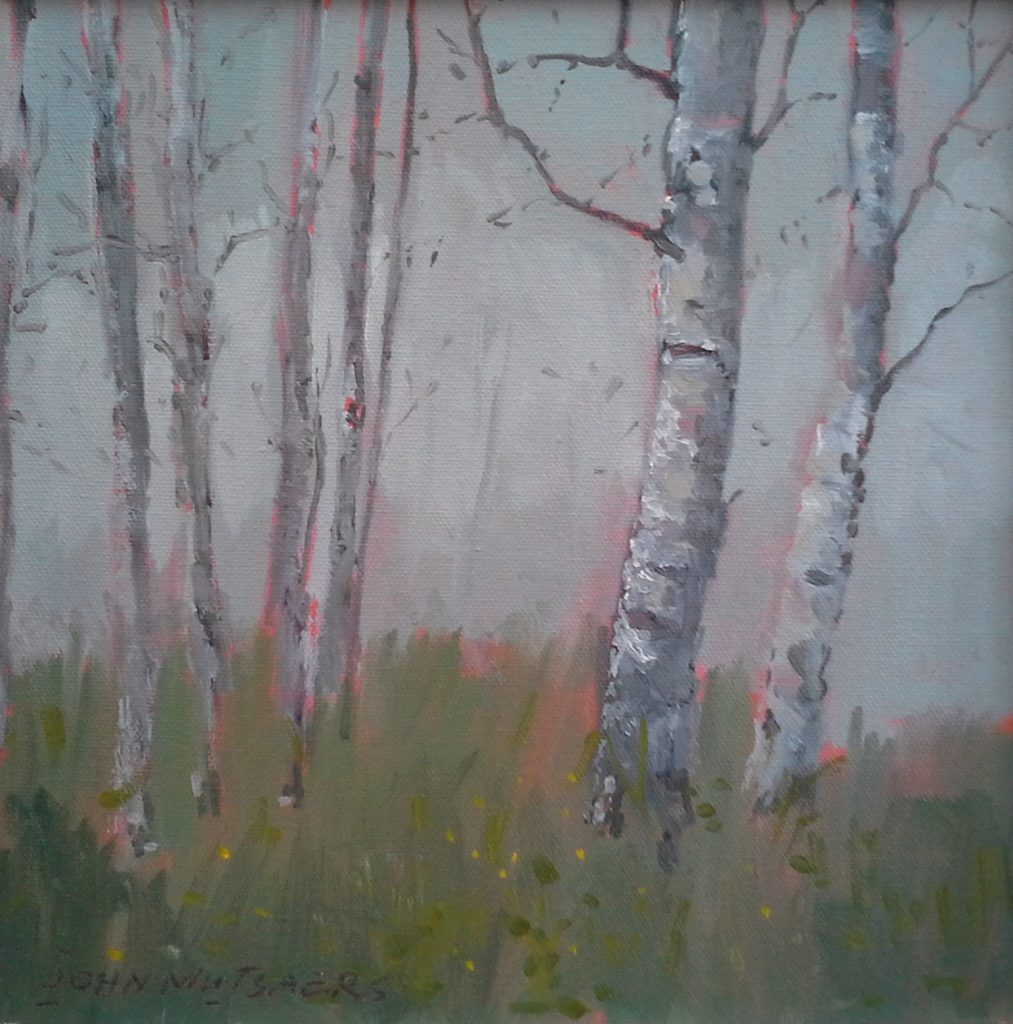
Misty Creek, Oil on Canvas, 30 x 30cm
Shadows play a large part in your work, expand on this aspect.
Shadows are like anchors; they literally tie things down. Without shadows there is no third dimension in a depiction on a two-dimensional plane like an artist’s canvas or paper. Like most people, shadows fascinated me as a child and for me this fascination is an ongoing love affair. A small example is my interest in the “penumbra”, which is the area between the shadow and light. This is not easily seen but illustrates that there is always something more. The other thing about shadow is that it too is a light; if it were not so it would be invisible. Our eyes are sensitive to light and as such shadows are just a darker light. The name for the colour, Umber comes from this word. As a poet I have written about shadows. Here is one I wrote a few years ago.
Penumbra
On the edge of every shadow
Behold a slender meridian
The lighter grey of life
A choice to face the light
Renders void the shadow and its penumbra
Unobserved it exists and pursues
Spiritual and likewise complicated
Attached without sharpness
Turning our back on light
We turn and face our shadow
Even in that phase we have selection
Yet we have not observed the penumbra
The lighter grey of life
The existence of the third light
Another dimension that can’t be entered into
Mostly unknown, even by those who observe
A choice only for the choosers
Discuss your portrait, Emma (aged 8)
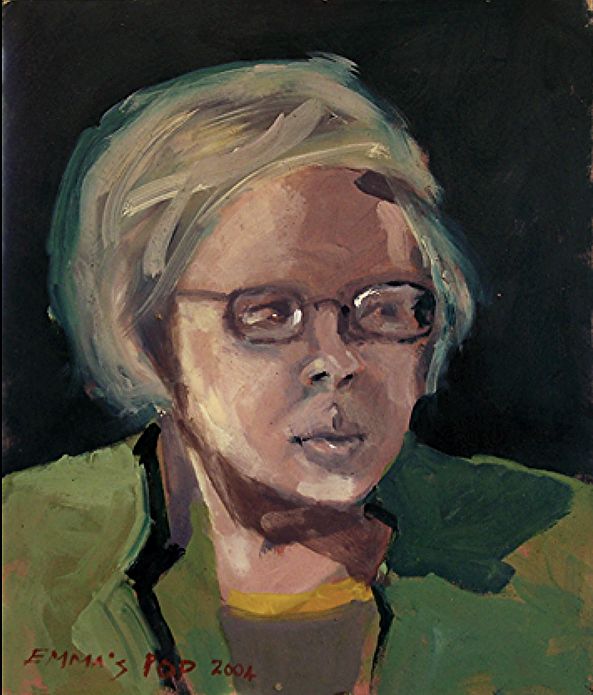
Emma is my beautiful and delightful grand-daughter who is now 20 years old. At the time when I painted her she was one of only two grandchildren. We are considerably wealthier now with an additional five grandchildren all under the age of seven; so there is hope for another portrait. I painted Emma while relaxing at our holiday house in Inverloch, which is now our home. She was the only one who had the patience to sit for me. Her older brother didn’t like the idea at all and the one time I tried to paint him he lost interest within minutes.
How often do you paint your own family?
I would have to say that in the span of my long career I have seldom painted my family. I painted my wife Mary twice and each of our four children only once as a Christmas gift. However, that is not to say that I don’t use them from time to time as models when I need a particular set of clothes shown or a hand model.
Being an artist is perhaps a curios occupation. Unlike a butcher or a teacher where the work they do belongs in a work place that is not their home my studio has always been at home and therefore no big deal for my family.
The way you have signed the work.
About thirty years ago I saw a documentary about a Japanese artist who believed that when you sign your work you give it your spirit. He would only sign his work when he was completely satisfied that the work was finished to the highest standard. I love that idea and have adopted it for myself. I have discussed this with my peers who work in a variety of disciplines and modalities and their opinions vary from never signing their work to making their signature a feature. With the ethos of the Japanese artist firmly in mind I love signing my work indicating my pride in it and a sense of achievement. The dots over and under the letters indicate when it was painted.
Pink – plays a huge part in your paintings, expand on the use of pink in your work.
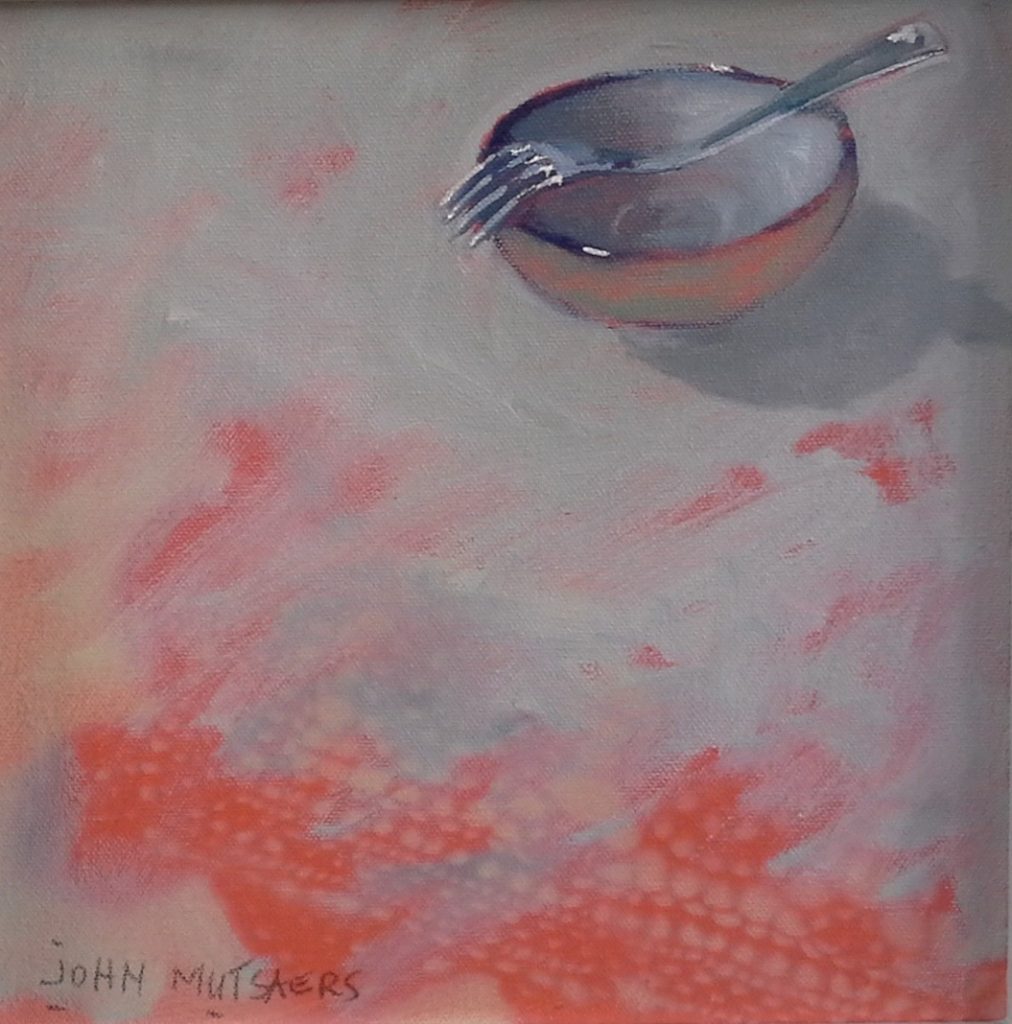
Still Life with With Silver Fork, Oil on Canvas, 30 x30cm
I have to admit that I have a longstanding fear of white canvas. I found the white canvas somewhat daunting and an agent for the opportunity to fail. It was somehow easier to make a start with a failsafe colour that was easily brushed onto the canvas using a large brush. A two-litre container of Gesso can accommodate a 10cm brush and because of its size and broadness is easy to use without the fear of mistakes. There was no way I could fail with a brush like that. It took me about a year to come up with an undertone that suited my palette. I now have a number of tinted gessoes that suit a variety of subjects and themes. It must be said, however, that I no longer fear white canvas; now I just don’t like it. The pink undertone is an essential part of my working style.
You say you love white; discuss your use of this tonal colour?
In light of my confessed dislike of white canvas this must seem somewhat of a contradiction but I don’t have an aversion to white when it comes out of a tube. On the contrary, I am in love with the variety white paint brings to a subject. I love how it expresses light and accentuates the darks. A simple flick of it on the rim of a glass, for example, can emphasise the third dimension while maintaining and enhancing the integrity of the delicate nature of glass. I love the myriad of after-tones white has to articulate shadows and coolness when mixed with red, yellow and blue to make grey. I love the fact that white is not a colour but rather a tone that has the ability to change everything around it. Perhaps I should write a book about WHITE.

Bird in Flight, Oil on canvas, 93 x 93cm
You have been very fortunate to be influence by some ‘big’ names in the Australian art world, discuss.
My earliest influence was my mother who was not an artist herself but loved art enough to take me on frequent visits to an art supply shop. Across the street from this art shop was the Van Abbe Museum in Eindhoven, our hometown. Our regular visits there exposed me to the idea that art is valuable and that artists do important work. Being the only boy in a family with five sisters, she understood my need to do different things.
Buying art materials is still a passion and when I find myself in the exhilarating ambience of an art shop engulfed in the smell of turps and oil, among brushes and paint, I buy things that inspire me rather then just purchasing what I need.
There were also a few professional artists in my parents’ family. My mother had two brothers who were painters and on my father’s side of the family there are two notable painters here in Australia; Frank Mutsaers (Dec.) and Gerrard Mutsaers. Frank had a big influence on my early career.
My earliest influence of an artist outside of my family was Dutch artist Kees Bol who allowed me into his studio while he worked on his paintings. I was just a young boy at that time but he had a big influence on my future career. Mary and I were fortunate to see Kees in his studio one last time in Holland in 2008 two weeks before he died aged 93. Kees was an astonishing painter. – The Infinite Birdcage series started with a small painting I did to commemorate his death.
While there are many distinguished artists, now and in the past, which continue to inspire me, none had a bigger effect on my career than my teacher and mentor John Balmain. I spent five years learning and working with John in his studio in Dandenong. John was a great painter whose modesty probably held him back from the recognition he deserved. He was also an inventor of studio gadgets and tools; his ability to solve a problem, either on a canvas or in the studio was significant. A master of tone, he, more then anyone helped me to understand the nature of colour and how light plays its part. I can hear him now explaining the properties of reflection and refraction. Sadly, John passed away in 2000. His opinion on, The Infinite Birdcage, would have been insightful, valuable and much appreciated.
One who is a special friend and has been a good and honest critic.
My best friend is my wife Mary; we have grown together in this, sometimes-difficult career path. She is my greatest inspiration and my worst critic. Her honest and insightful commentary about my work, although painfully at times, is most helpful. During our fifty, year marriage there has never been a time when she would just say, “That’s nice John,” just to appease my ego. I know from the moment she walks into my studio whether on not I am on the right track. All artists need this kind of endorsement and I am so lucky to have her.
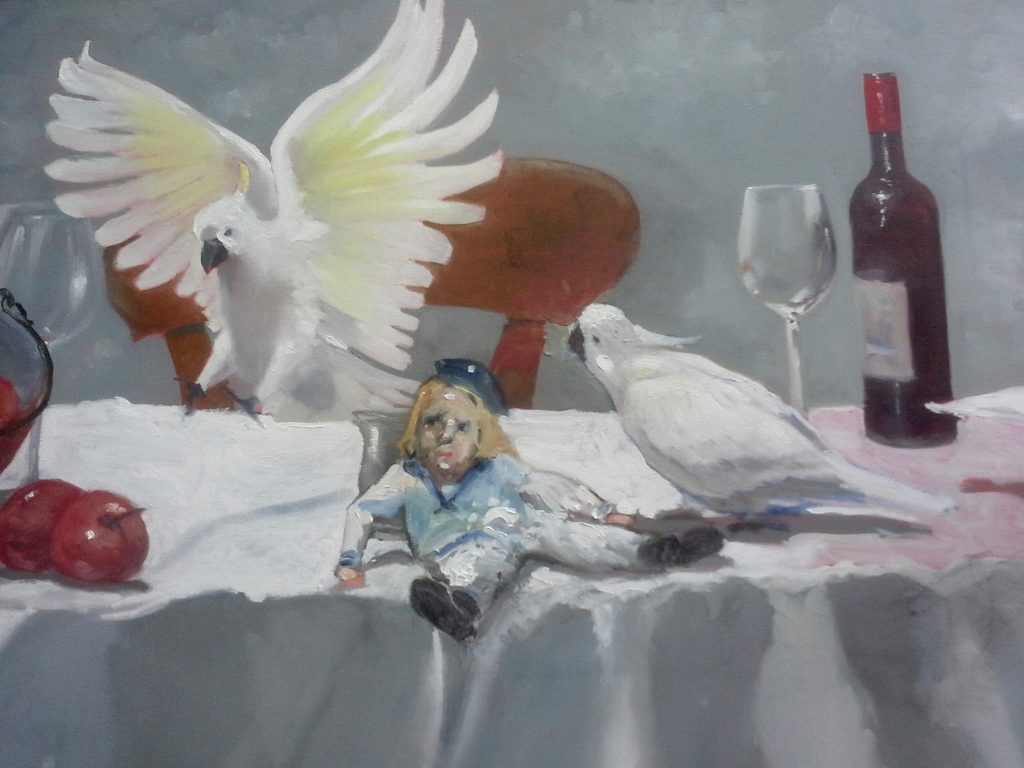
Detail, Untitled, Oil on canvas, 184 x 137cm
There are only a few artists whose opinions I regard as invaluable. I believe that there are clearly two categories of artists; those who make a living from their work without regard for the sanctity of the craft, and those who love the purity of an idea and their ardent, committed truths in every brushstroke. I highly regard artists who have an artist heart.
Discuss the importance of Experiential & Creative Art Therapy?
The impetus for undertaking my course in Art Therapy was when I was asked to work with a young boy in a primary school who needed help. He was clever at drawing and painting and so the principal of the school thought that he would benefit from working with me. I was used to working with children as an artist but not as a therapist especially with an anxious child who was disconnected both at home and at school. Initially I thought that I would be able to do work with this young man just relying on my artistic ability but I soon found that I didn’t have the skills needed. On the recommendation of a friend I enrolled at the Melbourne Institute of Experiential and Creative Art Therapy, MIECAT. While my intention was to study in order to help this young student I have to admit that I was by far the major beneficiary. What I learned about the real purpose of art was astonishing. I spent the next four years studying for my Masters Degree, which turned out to be the most important studies I have ever undertaken.
I was a competent artist proficient in all the technical aspects of the craft but I don’t believe I ever understood what art is for. I had often used the idiom – Humans are the only creatures in the known universe who make art. However, while that statement is absolutely true it does not explain how art is valuable or, how we ought to use it. I spent four years finding out that art has healing powers, not in a kind of magical or shamanistic sense but as a way to look at life differently. More to the point art can open windows into our own idiosyncratic behaviour and in particularly the way you think.
Art is a language, a way of making sense of the whole kit and caboodle we call life. Throughout the ages art has been used as a way of expressing thoughts and emotions and conveying them to others. A simple example would be our feelings towards colour; most people can attest that some colours make them happy and some provoke sadness. Graphic designers certainly know the value of colour and which shapes and patterns are the most powerful.
Since studying Art Therapy I am more aware of the emotions I express and the experiences I bring to the viewer of my work. I don’t believe that I could have undertaken such a significant theme as, “Freedom” – The Infinite Birdcage without having a background in Art Therapy.

Untitled, Oil on canvas, 184 x 137cm
As well as applying this newfound knowledge in my own work I also instigated an art therapy based studio called ArtsBillabong in 2002. This studio operated two days per week and was set up especially for high school students who were at risk of not completing their studies, experimenting with drugs and engaged in unsociable behaviours. Three other MIECAT graduates made up the ArtsBillabong team. Although it was exceptionally successful it was unfortunately closed down at the end of 2015 due to lack of funds.
Contact details.
John Mutsaers
opusjoop1@gmail.com
www.jmartist,com.au
John Mutsaers, Inverlock, Australia
Interview by Deborah Blakeley, June, 2016
Think a colleague or friend could benefit from this interview?
Knowledge is one of the biggest assets in any business. So why not forward this on to your friends and colleagues so they too can start taking advantage of the insightful information the artist has given?
Other artists you may be interested in:



